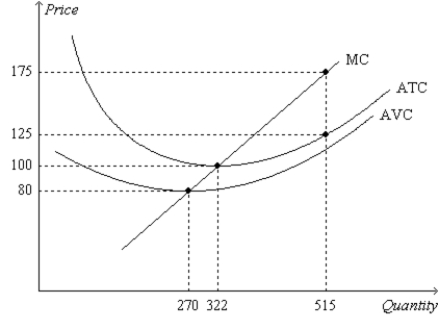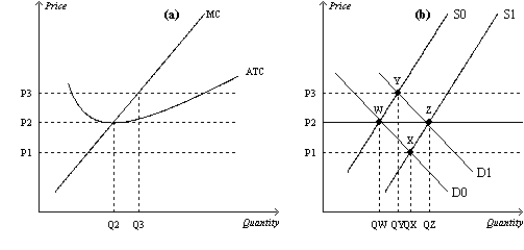A) more firms will enter the market.
B) some firms will exit from the market.
C) the equilibrium price per duck call will fall.
D) average total costs will fall.
F) B) and D)
Correct Answer

verified
Correct Answer
verified
Multiple Choice
A profit-maximizing firm in a competitive market is able to sell its product for $7. At its current level of output, the firm's average total cost is $10. The firm's marginal cost curve crosses its marginal revenue curve at an output level of 9 units. The firm experiences a
A) profit of more than $27.
B) profit of exactly $27.
C) loss of more than $27.
D) loss of exactly $27.
F) All of the above
Correct Answer

verified
Correct Answer
verified
Multiple Choice
In a perfectly competitive market, the market supply curve is
A) the marginal cost curve above average total cost for a representative firm.
B) the horizontal sum of all the individual firms' supply curves.
C) the vertical sum of all the individual firms' supply curves.
D) always a horizontal line.
F) A) and B)
Correct Answer

verified
Correct Answer
verified
Multiple Choice
When a restaurant stays open for lunch service even though few customers patronize the restaurant for lunch, which of the following principles is are) best demonstrated? i) Fixed costs are sunk in the short run. Ii) In the short run, only fixed costs are important to the decision to stay open for lunch. Iii) If revenue exceeds variable cost, the restaurant owner is making a smart decision to remain open for lunch.
A) i) and ii) only
B) ii) and iii) only
C) i) and iii) only
D) i) , ii) , and iii)
F) B) and C)
Correct Answer

verified
Correct Answer
verified
Multiple Choice
Scenario 14-1 Assume a certain firm in a competitive market is producing Q = 1,000 units of output. At Q = 1,000, the firm's marginal cost equals $15 and its average total cost equals $11. The firm sells its output for $12 per unit. -Refer to Scenario 14-1. At Q = 999, the firm's total costs equal
A) $10,985.
B) $10,990.
C) $10,995.
D) $10,999.
F) All of the above
Correct Answer

verified
Correct Answer
verified
Multiple Choice
If the market elasticity of demand for potatoes is -0.3 in a perfectly competitive market, then the individual farmer's elasticity of demand
A) will also be -0.3.
B) depends on how large a crop the farmer produces.
C) will range between -0.3 and -1.0.
D) will be infinite.
F) B) and D)
Correct Answer

verified
Correct Answer
verified
Multiple Choice
A profit-maximizing firm in a competitive market will always make marginal adjustments to production as long as
A) average revenue is greater than average total cost.
B) average revenue is equal to marginal cost.
C) marginal cost is greater than average total cost.
D) price is above or below marginal cost.
F) A) and B)
Correct Answer

verified
Correct Answer
verified
Multiple Choice
Figure 14-7  -Refer to Figure 14-7. In the short run, the firm's maximum profit or minimum loss) is the same at which of the following pairs of prices?
-Refer to Figure 14-7. In the short run, the firm's maximum profit or minimum loss) is the same at which of the following pairs of prices?
A) $65 and $75
B) $75 and $85
C) $80 and $100
D) $125 and $175
F) A) and B)
Correct Answer

verified
Correct Answer
verified
Multiple Choice
Comparing marginal revenue to marginal cost i) reveals the contribution of the last unit of production to total profit. Ii) is helpful in making profit-maximizing production decisions. Iii) tells a firm whether its fixed costs are too high.
A) i) only
B) i) and ii) only
C) ii) and iii) only
D) i) and iii) only
F) B) and C)
Correct Answer

verified
Correct Answer
verified
Multiple Choice
Table 14-3
The table represents a demand curve faced by a firm in a competitive market.
 -Refer to Table 14-3. For this firm, the average revenue is
-Refer to Table 14-3. For this firm, the average revenue is
A) $39.
B) $26.
C) $13.
D) $0.
F) A) and D)
Correct Answer

verified
Correct Answer
verified
Multiple Choice
Table 14-9
Suppose that a firm in a competitive market faces the following revenues and costs:
 -Refer to Table 14-9. In order to maximize profit, the firm will produce a level of output where marginal revenue is equal to
-Refer to Table 14-9. In order to maximize profit, the firm will produce a level of output where marginal revenue is equal to
A) $6.
B) $7.
C) $8.
D) $9.
F) C) and D)
Correct Answer

verified
Correct Answer
verified
Multiple Choice
Which of the following represents the firm's short-run condition for shutting down?
A) shut down if TR < TC
B) shut down if TR < FC
C) shut down if P < ATC
D) shut down if TR < VC
F) B) and D)
Correct Answer

verified
Correct Answer
verified
Multiple Choice
Table 14-11
Suppose that a firm in a competitive market faces the following prices and costs:
 -Refer to Table 14-11. The marginal revenue from producing the 3rd unit equals i) $6.
Ii) the price.
Iii) the marginal cost.
-Refer to Table 14-11. The marginal revenue from producing the 3rd unit equals i) $6.
Ii) the price.
Iii) the marginal cost.
A) i) only
B) i) and ii) only
C) iii) only
D) i) , ii) , and iii)
F) A) and C)
Correct Answer

verified
Correct Answer
verified
Multiple Choice
When determining whether to shut down in the short run, a competitive firm should ignore i) fixed costs. Ii) variable costs. Iii) sunk costs.
A) iii) only
B) i) and iii) only
C) ii) only
D) i) , ii) , and iii)
F) A) and C)
Correct Answer

verified
Correct Answer
verified
Multiple Choice
Table 14-11
Suppose that a firm in a competitive market faces the following prices and costs:
 -Refer to Table 14-11. Marginal revenue equals marginal cost when the firm produces
-Refer to Table 14-11. Marginal revenue equals marginal cost when the firm produces
A) 2 units.
B) 3 units.
C) 4 units.
D) 5 units.
F) B) and D)
Correct Answer

verified
Correct Answer
verified
Multiple Choice
When firms are neither entering nor exiting a perfectly competitive market,
A) total revenue must equal total cost for each firm.
B) economic profits must be zero.
C) price must equal the minimum of marginal cost for each firm.
D) Both a and b are correct.
F) None of the above
Correct Answer

verified
Correct Answer
verified
True/False
In making a short-run profit-maximizing production decision, the firm must consider both fixed and variable cost.
B) False
Correct Answer

verified
Correct Answer
verified
Multiple Choice
Figure 14-14
 -Refer to Figure 14-14. Suppose a firm in a competitive market, like the one depicted in panel a) , observes market price rising from P1 to P2. Which of the following could explain this observation?
-Refer to Figure 14-14. Suppose a firm in a competitive market, like the one depicted in panel a) , observes market price rising from P1 to P2. Which of the following could explain this observation?
A) The entry of new firms into the market.
B) The exit of existing consumers from the market.
C) An increase in market supply from S0 to S1.
D) An increase in market demand from D0 to D1.
F) A) and B)
Correct Answer

verified
Correct Answer
verified
Multiple Choice
Which of the following statements is correct regarding a firm's decision-making?
A) The decision to shut down and the decision to exit are both short-run decisions.
B) The decision to shut down and the decision to exit are both long-run decisions.
C) The decision to shut down is a short-run decision, whereas the decision to exit is a long-run decision.
D) The decision to exit is a short-run decision, whereas the decision to shut down is a long-run decision.
F) B) and D)
Correct Answer

verified
Correct Answer
verified
True/False
The long-run equilibrium in a competitive market characterized by firms with identical costs is generally characterized by firms operating at efficient scale.
B) False
Correct Answer

verified
Correct Answer
verified
Showing 81 - 100 of 543
Related Exams